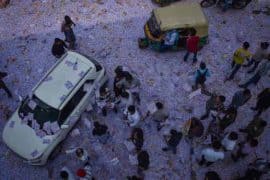Nature has inspired art in a myriad of ways, be it music, literature, movies or paintings. This has acted as a tool to not only connect with the world around one but also rediscover it through aesthetic eyes.
Our art is an extension of a never-ending quest for soul searching, a gaze into the depths of our being- into the depths of what lies around us. We find inspiration in the complexities of the world around us, in the bustling streets of the city and the quaint hills of the countryside. The world around us in all of its natural glory is but our greatest muse- nature brings out feelings and emotions and beautiful art from within the depths of our mental limitations.
Nature is our greatest artistic muse, and it has inspired many great works in the past- both overtly and covertly. It has manifested as a backdrop for startling drama and chaos as well as symbolised inner meanings of what artists try to bring out, it often takes a centre stage as the overarching theme and umbrella under which everything unfolds, be it literature, movies and paintings. Our subtle and romantic relationship with the beauty of nature- be it snowy peaked mountains or pinky sandy beaches, the leafy green of a luscious hillside or the sensual golden of dunes in the desert inspires both performative and literary art in inexplicable ways.
In both movies and music, nature is infused with emotion and the sounds of nature are used to complement the dialogue and artistry of the medium. A lot of music is derived from the sound and essence of nature, like Chopin’s raindrops, inspired by the soft mellow sound of raindrops falling. In many movies, nature is used strategically not only to contribute to magnificent sets but also woven into subtle aspects of the plot, like the movie October, and the Shiuli flower, after which the lead female character is named.
In literature, some of the most famous work has been inspired by or symbolised through nature. William Shakespeare’s iconic “Shall I compare thee to a Summer’s Day” is a sonnet written comparing his lover to a summer’s day, using it as an allegory to bring out both beauty and immortality. This has been used as a poem of love for time immemorial- a testament to the endless beauty of nature and natural allegories. Many of Wordsworth’s poetry, like “Daffodils” and “I wander lonely as a cloud”, are inspired by the humaneness of aspects of nature, speaking to the emotions of loneliness and happiness subjectively. In these poems, the artist has a simplistic yet profound relationship both with his art as well as the nature that inspired it- a versatile canvas as well as a theme for art across time and space. Other poetry and great works of literature, like the Tempest, refer to deeper symbolic themes like a psychological storm and experiences of confusion, of conflict both inward and between characters, as well as a backdrop for action and drama.
Often, art depicts nature in its most explicit form, as we see in the breathtaking painting Starry Night by Van Gogh, Water Lilies by Monet or Sunlight and Shadow by Heade. These are not only vivid portrayals of nature but also expressive of the implicit emotions and feelings behind these portrayals, the angst or the wander, the light and the shadow.
Nature has a complicated relationship with the different kinds of art as well as the artist, and sometimes this journey of emulating nature in one’s art can be a spiritual experience of connecting with something bigger than oneself.
Read also:
https://dubeat.com/2015/03/teri-collaboration-tetra-pak-launches-network-nature/
https://dubeat.com/2012/10/signature-campaign-by-tibetan-youth-congress/
https://dubeat.com/2020/04/the-call-for-earths-voice-to-be-heard/
https://dubeat.com/2015/11/peaking-into-the-real-heaven-on-earth-kashmir-du-beat/
Featured Image Credits: Starry Nights
Riddhi Mukherjee




Comments are closed.